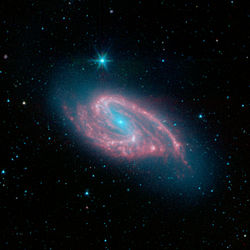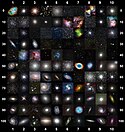Sig12-013
Credit
NASA/CXC/Ohio State Univ./C.Grier et al.; Optical: NASA/STScI, ESO/WFI; Infrared: NASA/JPL-CaltechThe spiral galaxy NGC 3627 is located about 30 million light years from Earth. This composite image includes X-ray data from NASA's Chandra X-ray Observatory (blue), infrared data from the Spitzer Space Telescope (red), and optical data from the Hubble Space Telescope and the Very Large Telescope (yellow). The inset shows the central region, which contains a bright X-ray source that is likely powered by material falling onto a supermassive black hole.
A search using archival data from previous Chandra observations of a sample of 62 nearby galaxies has shown that 37 of the galaxies, including NGC 3627, contain X-ray sources in their centers. Most of these sources are likely powered by central supermassive black holes. The survey, which also used data from the Spitzer Infrared Nearby Galaxy Survey, found that seven of the 37 sources are new supermassive black hole candidates.
Confirming previous Chandra results, this study finds the fraction of galaxies found to be hosting supermassive black holes is much higher than found with optical searches. This shows the ability of X-ray observations to find black holes in galaxies where relatively low-level black hole activity has either been hidden by obscuring material or washed out by the bright optical light of the galaxy.
The combined X-ray and infrared data suggest that the nuclear activity in a galaxy is not necessarily related to the amount of star-formation in the galaxy, contrary to some early claims. In contrast, these new results suggest that the mass of the supermassive black hole and the rate at which the black hole accretes matter are both greater for galaxies with greater total masses.
A paper describing these results was published in the April 10, 2011 issue of The Astrophysical Journal. The authors are Catherine Grier and Smita Mathur of The Ohio State University in Columbus, OH; Himel GHosh of CNRS/CEA-Saclay in Guf-sur-Yvette, France and Laura Ferrarese from Herzberg Institute of Astrophysics in Victoria, Canada.
NASA's Marshall Space Flight Center in Huntsville, Ala., manages the Chandra program for NASA's Science Mission Directorate in Washington. The Smithsonian Astrophysical Observatory controls Chandra's science and flight operations from Cambridge, Mass. About the Object
Credit
NASA/CXC/Ohio State Univ./C.Grier et al.; Optical: NASA/STScI, ESO/WFI; Infrared: NASA/JPL-Caltech
Name
NGC 3627
Type
Galaxy > Type > Spiral Galaxy > Component > Central Black Hole
Distance
29,000,000 Light Years
Color Mapping Band Wavelength Telescope X-ray 1.5 keV Chandra ACIS Optical 429 nm VLT WFI Optical 554 nm VLT WFI Optical 657 nm VLT WFI Optical 814 nm Hubble WFPC2 Optical 658 nm Hubble WFPC2 Optical 555 nm Hubble WFPC2 Optical 814 nm Hubble ACS/WFC Optical 555 nm Hubble ACS/WFC
Infrared 4.5 µm Spitzer IRACRelevante Bilder






Relevante Artikel
Messier 66Messier 66 ist eine Spiralgalaxie vom Hubble-Typ Sb im Sternbild Löwe. Der tatsächliche Durchmesser beträgt etwa 100 000 Lichtjahre. .. weiterlesen
